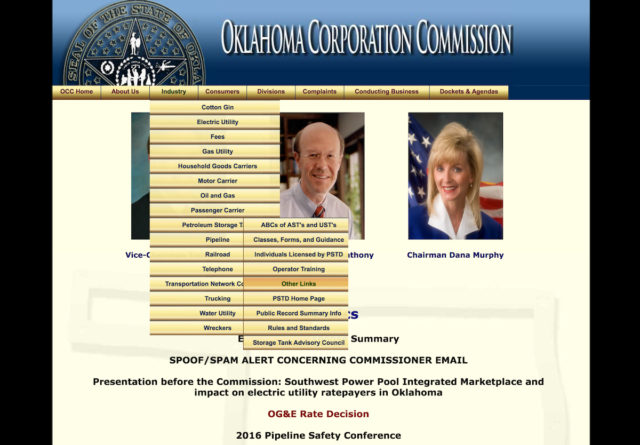At least prima facie, the Oklahoma Corporation Commission is a mess. It can’t even be called a “hot mess.”
Let’s start with the OCC’s website, copyright 20 years ago. You know it’s a website because — despite being a state agency supported by three statewide-elected officials — its URL is www.OCCEWEB.com. That’s actually the only way to know something is a website. You’ve got to put “web” in it, and you’ve got to renew the URL each year from Danica Patrick’s company GoDaddy. The State of Oklahoma does not have its own set of domains, right?
Once they get to www.OCCEWEB.com, visitors are treated to a navigation menu featuring 204 navigation-menu links, many of which are duplicative (Same | Page). Site administrators list priority items under “Hot Topics” in the middle of the home page, including this 2011 Joomla site called Michael4Safety.net. It teaches “Well Site Safety Fast Facts,” features an MS-Paint-based .swf file and displays the instructions:
Click BACK BUTTON on BROWSER to get back to SITE!
ThANkS! (Apple/Ctrl + [ will also do the trick.)
OCC digital document access appears limited
In the middle of current Hot Links sit a few other examples of the OCC’s messy operations, one less serious than the other.
Of minor importance is a “Spoof/Spam Alert” that features this problematic sentence:
Stakeholders and other entities that do business with the OCC have reported that they have received emails at first glance appear to be from a Commissioner, but upon closer examination, are from someone “spoofing” the Commissioner’s email address.
Perhaps OCC staff are also “spoofing” the public by pretending to issue typo- and error-filled notices?
Regardless, Oklahomans’ attention on the OCC website should be drawn to the hotlink-titled “OG&E rate case,” which opens a 70-word announcement that commissioners had finally settled a controversial decision after 15 months.
While at first glance the decision looks to be a win for ratepayers (who will only see an average increase of $0.72 per month on their bills), the broader implications of the decision and questions about how it was handled underscore a bigger problem.
First, the OCC took so long in determining the OG&E rate-increase request that the power company exercised an option available to it under state law of setting new rates because the regulatory body failed to do its job in a timely fashion.
Second, anyone looking to find the actual “final order” from the case apparently has to go to OG&E’s website, which lists dozens of documents related to the complex and important decision. Finding any of those documents online from OCC itself — the publicly funded state agency — appears impossible, despite those 204 menu links.
It begs the question: What do commissioners and their staff think they are doing with their website if not posting important documents about a major rate case? (Hint: Check out that .swf file.)
Administrative judge decision irrelevant?
As for the rate case itself, the situation is exceedingly complicated and full of numerous figures, percentages and calculations, but the result boils down thusly:
OG&E functionally requested the ability to recoup an $85.6 million “revenue deficiency” that the company estimated and other parties adjusted in reference to various infrastructure improvements, depreciations and maintenance programs, among other things.
Administrative law judge Ben Jackson presided over hearings on the case from October 2015 to May 2016. After all was said and done, he recommended that commissioners approve $60.3 million in rate increases for OG&E.
But commissioners ultimately approved only $8.9 million of the proposal. That only about 10 percent of the amount requested and almost 15 percent of Jackson’s recommendation.
How did commissioners come to that decision? The 260-page PDF below represents their final order. Its stark contrast to the administrative law judge’s findings raises more questions about how efficiently and effectively these cases are being handled.
Is OG&E asking for too much in their initial filings? Are commissioners awarding too little in their final orders? The disparity in the numbers would imply “yes” to both of those questions.
Unfortunately, the regulatory processes of the Oklahoma Corporation Commission appear too messy for the average citizen to have much clue about what’s actually going on.
If commissioners want to take one step in the right direction, they could ask the Oklahoma Office of Management and Enterprise Services to help make their website functional.
